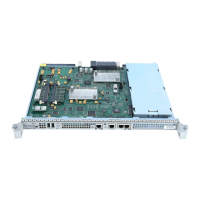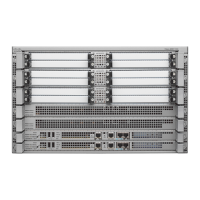PurposeCommand
Sets an encapsulation type on the interface:
• hdlc—High-Level Data Link Control (HDLC)
protocol for serial interface. This encapsulation
method provides the synchronous framing and
error detection functions of HDLC without
windowing or retransmission. This is the default
for synchronous serial interfaces.
• ppp—PPP (for serial interface).
• frame-relay—Frame Relay (for serial interface).
Router(config-if)# encapsulation encapsulation-type
{hdlc | ppp | frame-relay}
Verifying Encapsulation
Use the show interfaces serial command to verify encapsulation on the interface:
Router# show interfaces serial 2/0/0:0
Serial2/0/0:0 is down, line protocol is down
Hardware is SPA-8XCHT1/E1
MTU 1500 bytes, BW 1536 Kbit, DLY 20000 usec,
reliability 255/255, txload 1/255, rxload 1/255
Encapsulation PPP, crc 32, loopback not set
Keepalive set (10 sec)
LCP Closed, multilink Closed
Last input 1w0d, output 1w0d, output hang never
Last clearing of show interfaceunters 6d23h
Input queue: 0/75/0/0 (size/max/drops/flushes); Total output drops: 0
Queueing strategy: weighted fair
Output queue: 0/1000/64/0 (size/max total/threshold/drops)
Conversations 0/0/256 (active/max active/max total)
Reserved Conversations 0/0 (allocated/max allocated)
Available Bandwidth 1152 kilobits/sec
30 second input rate 0 bits/sec, 0 packets/sec
30 second output rate 0 bits/sec, 0 packets/sec
0 packets input, 0 bytes, 0 no buffer
Received 0 broadcasts (0 IP multicast)
0 runts, 0 giants, 0 throttles
0 input errors, 0 CRC, 0 frame, 0 overrun, 0 ignored, 0 abort
0 packets output, 0 bytes, 0 underruns
0 output errors, 0 collisions, 0 interface resets
0 output buffer failures, 0 output buffers swapped out
0 carrier transitions alarm present
Timeslot(s) Used:1-24, subrate: 64Kb/s, transmit delay is 0 flags
Configuring the CRC Size for T1
All 8-Port Channelized T1/E1 Serial SPA interfaces use a 16-bit cyclic redundancy check (CRC) by default,
but also support a 32-bit CRC. CRC is an error-checking technique that uses a calculated numeric value to
detect errors in transmitted data. The designators 16 and 32 indicate the length (in bits) of the frame check
sequence (FCS). A CRC of 32 bits provides more powerful error detection, but adds overhead. Both the sender
and receiver must use the same setting.
CRC-16, the most widely used CRC throughout the United States and Europe, is used extensively with WANs.
CRC-32 is specified by IEEE 802 and as an option by some point-to-point transmission standards. It is often
used on Switched Multimegabit Data Service (SMDS) networks and LANs.
Cisco ASR 1000 Series Aggregation Services Routers SIP and SPA Software Configuration Guide, Cisco IOS
XE Everest 16.5
230 OL-14127-17
Configuring the 8-Port Channelized T1/E1 Serial SPA
Optional Configurations

